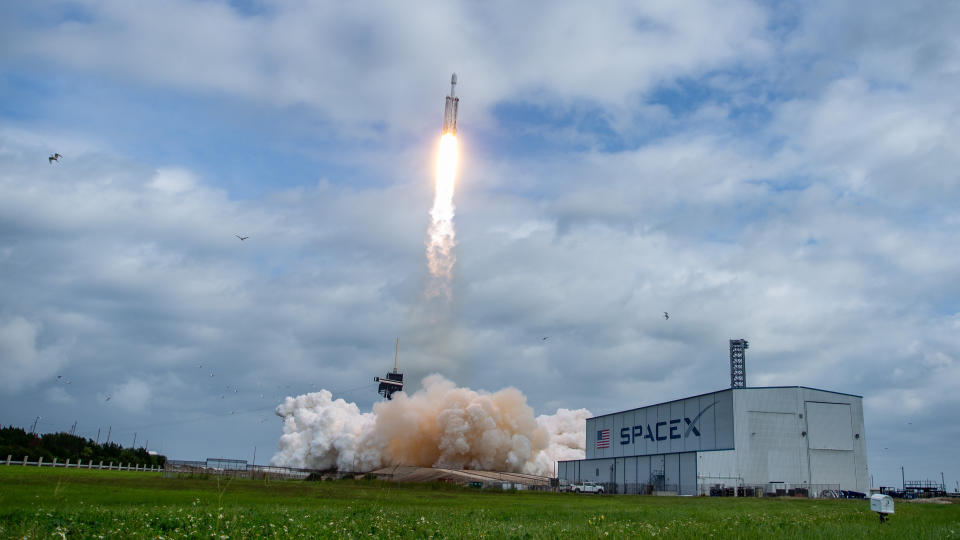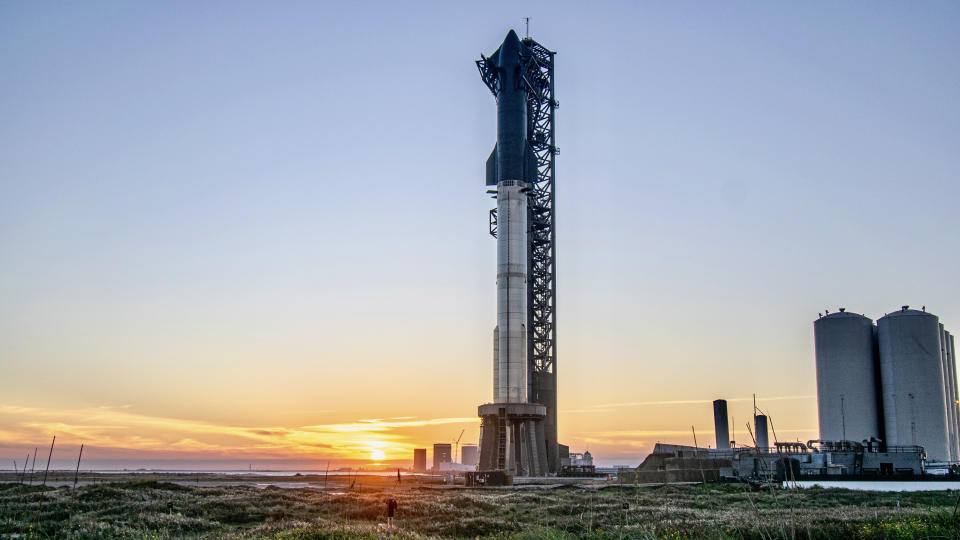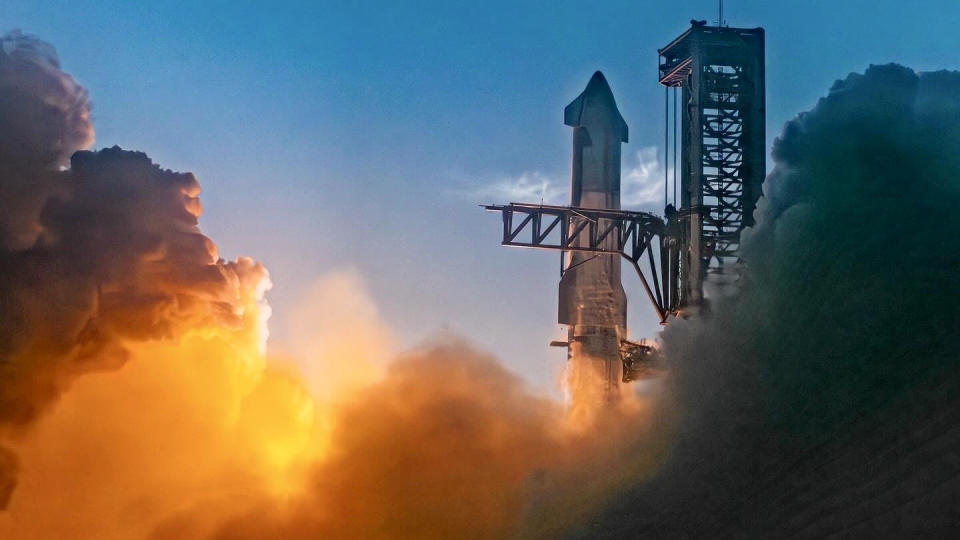SpaceX’s plans to launch its Starship–Super Heavy two-stage rocket 44 times a year from NASA’s Kennedy Space Center in Florida have come under fire from its two biggest rivals: United Launch Alliance (ULA) and Jeff Bezos’ Blue Origin.
The Spaceship vehicle is the world’s largest rocket. Its two stages are SpaceX’s Super Heavy booster rocket and the upper-stage spacecraft, somewhat confusingly called Starship or “Ship,” which could one day carry a crew of up to 100 astronauts.
After being tested over the past few years, the Starship/Super Heavy design has undergone a number of upgrades, the latest of which has resulted in a rocket that will be up to 492 feet (150 meters) tall. To put this into context, the Saturn V was 363 feet (111 meters) tall, while the manned version of NASA’s new Space launch system is 322 feet 98 meters high. The SpaceX rocket is huge and the plan is to take astronauts to the moon And Mars.
For SpaceX may be granted a permit to commence launches from launch pad 39A on Kennedy Space Center (KSC) Florida is required to prepare an environmental impact statement detailing the effects that SpaceX’s launches would have on the local environment and wildlife, as well as on nearby businesses and residents. This is being done by the Federal Aviation Administration (FAA) and is currently in the consultation phase, where local businesses, organizations and members of the public can weigh in on the pros and cons of SpaceX’s plans. And, well, SpaceX’s rivals have not held back.
Blue Origin submitted a 3-page letter to the FAA, asking it to cap the number of launches and landings, reducing the planned 44 launches to an unspecified number “that will have minimal impact on the local environment, local operations personnel, and local community,” they wrote.
The Blue Origin Objections also raise the fact that the Starship–Super Heavy will contain “an unprecedented” 5,200 tons of liquid methane fuel, which is highly flammable and, if anything goes wrong, could cause a devastating explosion on the launch pad. Blue Origin claims the safety margins are so wide that they overlap with the launch pads, hangars and offices of several other companies, including Blue Origin itself on Launch Pad 36, all of which are leased from the Kennedy Space Center.
ULA’s criticism was even more severe in a 22 page document that the company submitted as part of the consultation. They are not holding back, accusing SpaceX of producing their own environmental impact assessment for their extravagantly named ‘Starbase’ in Boca Chica, Texas, from which they have been testing Starship to date.

In the letter, ULA points out that SpaceX’s environmental impact statement suggested that debris from a potential launch accident would cover only about 1 square mile (2.5 km²). In April 2023, during Starship’s first test flightinstead, debris was spread over a 6-mile (9.6 km) radius, endangering the surrounding area and demonstrating how much SpaceX had underestimated the danger to their environment. The explosion led to environmental groups to file a lawsuit against SpaceX and the FAA, which was ultimately dismissed in court. At Kennedy, ULA’s base is just 3 miles (4.8 km) from SpaceX’s launch pad 39A, which understandably makes them nervous.
“The increased thrust expected for Starship at launch would allow debris from a similar launch failure to reach larger, densely populated areas around KSC,” ULA said, recommending that SpaceX launch Starship from Boca Chica instead.
“As the world’s largest rocket,” ULA wrote, “an accident would cause severe or even catastrophic damage, while normal launch operations would have a cumulative impact on structures, launch vehicle hardware, and other critical launch support equipment.”
Blue Origin, on the other hand, proposed that the government build new launch pads further away from 39A, for companies like itself that could potentially be affected by SpaceX’s Starship activities.
There was also a lot of concern for the environment and local wildlife. To reach the goal of 44 launches per year, there would have to be at least 3 or 4 launches per month, which would result in launch pad 39A being in use all year round. The Merritt Island Wildlife Association (Merritt Island is the peninsula on which the Kennedy Space Center is located) pointed out that there will be spotlights in almost all locations time at 39A which disrupts the natural rhythm of wild animals, for example by causing migratory birds to get lost.


Meanwhile, the Defenders of wild animals organization in Florida point out that near Boca Chica, nesting bird eggs were cracked by falling pellets from previous Starship test flights. Birds nest near launch pad 39A, and more frequent launches would harm the bird population in the area. However, Defenders of Wildlife do say that they believe using 39A is better than building brand new launch pads on vacant land near Kennedy Space Center, as proposed by Blue Origin, which would also have a major impact on the environment.
An extensive investigation by the New York Times published on June 8 describes the environmental damage caused by SpaceX’s activities in Boca Chica, noting that the damage has fueled a debate “about how to balance technological and economic progress with the protection of fragile ecosystems and local communities.” While FAA leadership is aware of the environmental problems Starship poses, the agency has also stressed that the vehicle is vital to the U.S. room program.
“Blowing debris into state parks or national lands is not what we were calling for, but the bottom line is no one was hurt,” Kelvin B. Coleman, the FAA’s associate administrator for Commercial Space Transportation, told the New York Times. “We certainly don’t want people to feel like they’re being bulldozed. But this is a very important operation that SpaceX is doing there. It’s very important to our civil space program.”
It’s not just wildlife that could be affected by Starship. SpaceX’s water-flooding system sprays a million gallons of water onto the pad during launch to protect it from damage during launch by absorbing much of the heat. While much of this water evaporates, the rest drains into holding ponds around the launch site. ULA is wondering if and how this water will be treated for any toxic or otherwise dangerous chemicals in it, and what will prevent it from leaking into the water supply at large.


SpaceX also has its eye on a second launch pad, having inquired about using Launch Complex 37 at the adjacent Cape Canaveral Space Force Station starting in 2026. The U.S. Air Force is conducting its own environmental study of the proposal before granting approval.
ULA also questions SpaceX’s decision to stop using offshore drone ships to land the Super Heavy booster and instead return them to 39A, saying it “offloads the risks of system failure onto the communities, businesses and environment surrounding KSC.”
All three companies are competing for the same NASA contracts, and some observers may see these complaints as sour grapes from SpaceX’s rivals struggling to keep up. SpaceX’s Elon Musk responded to Blue Origin’s complaint in a seemingly mocking manner on social media, Posting “Sue Origin” on X (the social media company he owns) in the days following the company’s letter.
RELATED STORIES:
— SpaceX, FAA attempt to dismiss environmental lawsuit over Starship
— SpaceX announces it can catch Super Heavy booster with ‘chopsticks’ during upcoming Starship test flight (video)
— SpaceX joins FAA to fight environmental lawsuit against Starship: report
But whatever the motives behind the complaints, many of them appear to be relevant, involving safety and environmental impact. Even NASA has concerns; space agency officials have Previously mentioned that an incident on the launch pad could effectively reduce the scale of the disaster NASA of their only means to the International Space Stationwhich would leave astronauts stranded.
Both Blue Origin and ULA’s objections to Starship operations at KSC stem from the two companies’ belief that the rocket is too untested, too dangerous and too disruptive to fit into the ecosystem of Kennedy Space Center’s other users.
However, it will be up to the FAA to decide whether such concerns are valid and whether they are sufficient to prevent new aircraft from entering service. Elon Musk and prevent SpaceX from realizing their Starship dreams.